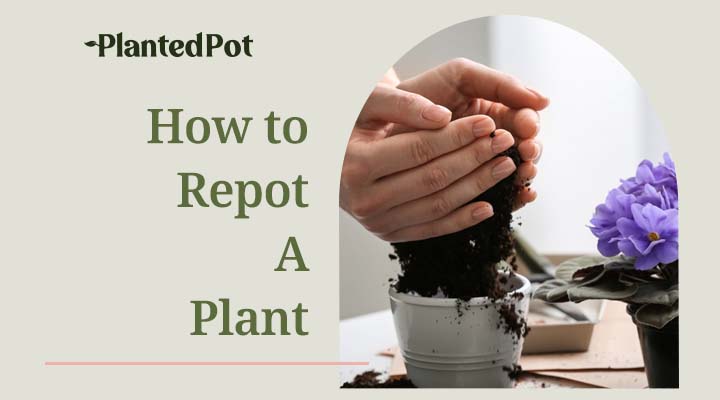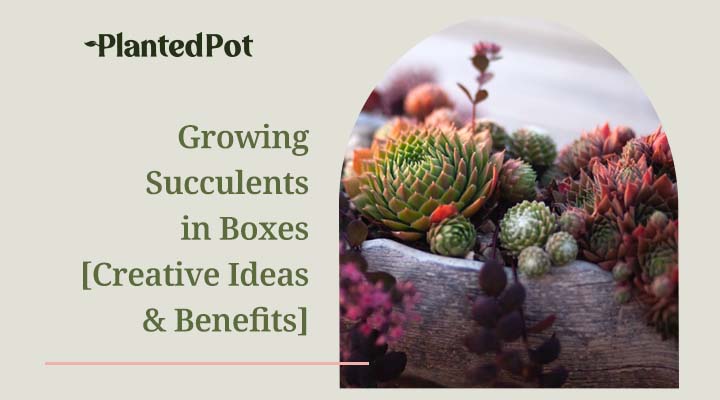
How To Water Succulents [Must-Know Plant Care Tips]
Home / How To Water Succulents [Must-Know Plant Care Tips]
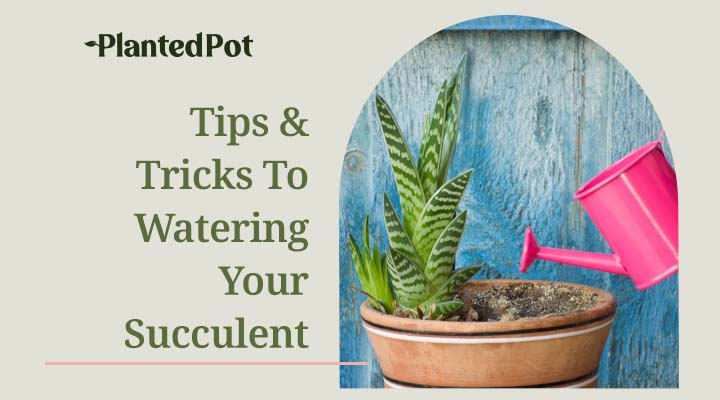
How To Water Succulents [Must-Know Plant Care Tips]
Succulent plants have found their way into nearly everyone’s home. They’re known for their low-maintenance needs and endurance through neglect, making them a popular no-fuss houseplant. Succulents are an easy way to connect with nature for even those with failing green thumbs. These plants require little sunlight, little water, and little pruning. If there’s only one thing you need to remember, it should be how to water succulents.
Don’t worry; it’s not as much work as you think it is. After all, succulents are quite forgiving of forgetful minds! However, to avoid making too many mistakes, we have a brief guide to keep you on the path to successful succulent management.
What Do You Need to Water Succulents?
Succulents are not like other house plants! If you try watering them like any other plant, they’re not likely to survive. Having the right tools for the job can make the work easier. When watering succulents, you only need a few things.
Containers
Succulents do not do well in soggy soil. Pooled water at the bottom of a pot causes soggy roots, which lead to root rot and other issues. Terracotta pots with a drainage hole are perfect for keeping potted succulents from being waterlogged. You can also make your drainage holes by using a drill to create a hole (or several) in ordinary plastic, ceramic, or clay plant pots. Covering the holes with a screen or partially blocking it with rocks or gravel will help keep soil from spilling out while still providing enough space for water to drain out.
It is possible to place your succulent in a container without drainage holes, but it is important to monitor these plants carefully. They should not be overwatered or left where they can be rained on, which will drown the succulent. Shallow pots work best in this case because you can measure soil moisture properly.
Soil Types
The right kind of soil mix can be a big help in keeping track of soil moisture. Cactus mix is useful because it doesn’t retain as much water as regular dirt does. This is ideal for plants that thrive in hotter, dryer environments like cacti (hence the name!). You can make your own cacti mix at home using ordinary potting soil, coarse sand or gravel, and a porous volcanic rock like pumice or perlite. Other great soils for succulent planting are those with primarily organic matter.
Peat moss, although great for plants, is not recommended for succulent plants. Peat moss has a controversial background due to its carbon emissions which have caused bans against its use in the UK. It is also not suitable for succulents because it is hard to wet and dries out quickly. Instead, adding a little finely ground bark or shredded coconut husks (coir) to ordinary potting soil makes it more water-absorbent.
You may need to adjust the kind of soil you use depending on the kind of succulents you own. For instance, aloe requires less soil drainage because they do not retain water as easily as agaves, which need more due to their high water retention capabilities.
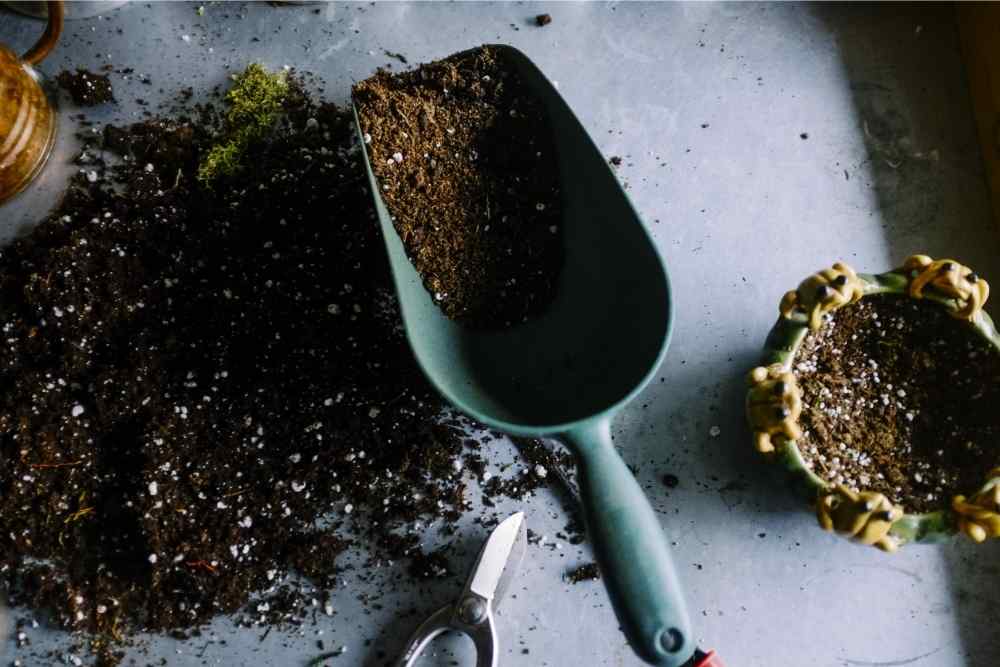
Testing the Soil
An easy way to test your soil’s drainage capacity is to wet the soil, grab a handful of it, and squeeze. If you open your hand and the soil remains stuck together in a ball, you need to add drainage material (like sand or wood chips) to your soil. Try a mixture of three parts soil for every three parts of drainage material and test again. If the wet soil mix crumbles easily in your hand after squeezing, it’s good to go!
Watering Tools
Traditional watering cans get the job done just fine because they’re widely available and affordable. Cans with long spouts are especially useful for watering the soil directly so that you can avoid drenching leaves in water. While the water may not cause the leaves to burn, as is mistakenly believed, this can cause water spots and leaf rot.
For compact arrangements, a squeeze bottle or watering syringe allows precise watering that can help you reach in between plant leaves to water soil evenly. They are also helpful when watering delicate or smaller-sized succulents that only require a small amount of water. A few gentle squeezes from these tools are all you need to keep your succulents watered.
Misting
A light misting with spray bottles is only meant for younger outdoor succulents, which dry out much faster than indoor succulents. Even then, it is recommended this only be done occasionally because water is not absorbed through the leaves of plants as much as it is through its roots. Misting younger succulents is usually done so you don’t overwater their delicate roots.
Succulents prefer dry, arid environments. Misting or wetting their leaves changes the humidity around the plant, which leads to brittle roots and moldy leaves.
Do Succulents Require a Watering Schedule?
No, succulents do not have a set schedule for when you should water them. Depending on the amount of sunlight and the roots’ absorption rate, their watering needs will vary. Usually, when the top few inches of soil are completely dry, it is a good time to re-water. This can range from every 3 to 14 days in warmer months and 14 to 28 days in winter months.
How Often Should Succulents Be Watered?
There is no universal schedule for how often you should water succulents. Bone dry soil or dry and brittle leaves are signs that your plant is dehydrated. Indoor and outdoor plants have different needs due to their differing climate and soil conditions. For succulents planted in pots, check the soil once a week to see how dry it is. If the soil is bone dry, it’s time to water!
Larger pots take longer to dry out, especially if the climate indoors is cool and humid. Waterings may lessen during winter months when succulents go into their dormant periods and grow less. Smaller pots need more frequent waterings because very little water is added to the soil at a time.
Summertime is a good time to move indoor succulents outdoors so they can get plenty of sunlight. In this case, indoor succulents turn into outdoor succulents, and their watering needs will change.
When succulents are planted in outdoor containers, watering habits remain similar to those planted indoors. Checking the soil for dryness is the best indicator that it is time to water, and that can range from a few days to a few weeks. However, they will usually require more water because their soil dries out faster than succulents residing indoors. Start by checking their soil once a week. If you find it drying out often, check the soil twice a week and water accordingly.
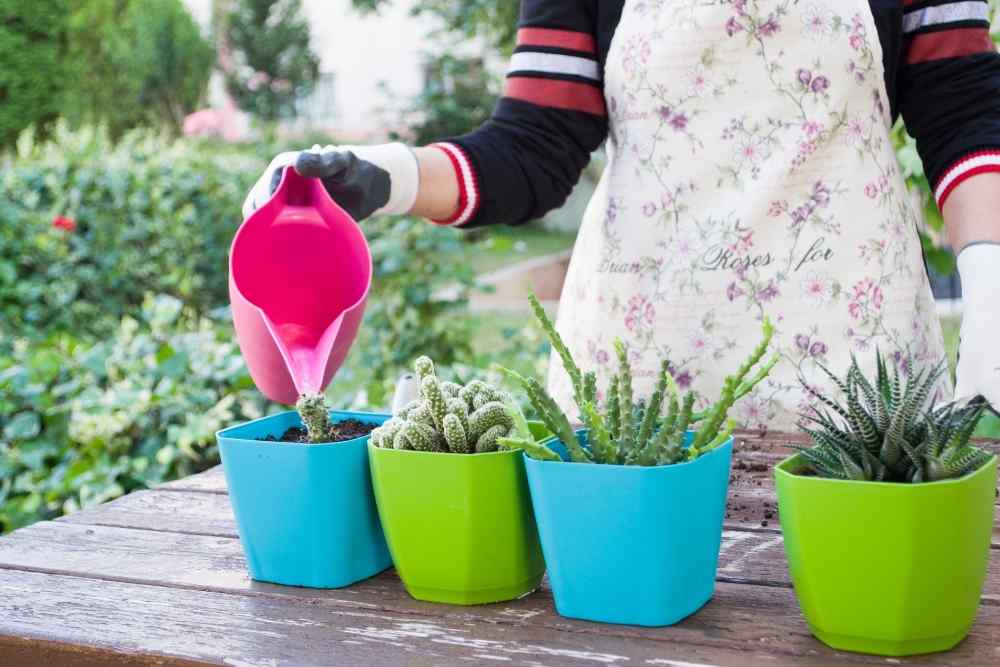
Planted in the Ground
For succulents with a more permanent residence in your outdoor garden, soil conditions should remain as dry as possible. In hotter months and climates, it’s best to check the soil more often; watering a few times a week during the summer is not uncommon. In rainy seasons and winter months, watering once a week, or up to four weeks might be enough.
How Do You Know When A Succulent Needs Water?
There are different ways to tell when a succulent needs water. If your succulent has any of the following, it may be dehydrated:
- Shriveled or wrinkled-looking leaves: Succulents store water in their stems and leaves. When they are not watered for a long time, they will use water stored there to rehydrate. When the water is removed, it gives the leaves a wrinkled appearance because their moisture has been drained.
- “Rubbery” leaves that bend easily: Flat leaves that droop or feel too soft lack moisture. This is another sign your succulent has used the water stored in its leaves to rehydrate itself.
- Dead, brown leaves: A succulent that has exhausted its internal water supply and has no way of replenishing it will eventually dry out and die. Browning leaves means your plant is dying fast!
- Aerial root growths: Small, white, or pink tendrils that grow out of the stem above the soil are called aerial growth (aerial = air, so air roots!). Succulents grow aerial roots to try and collect water from the air. Sometimes these are a sign that the environment around the succulent is humid, so if aerial roots appear with no other signs of dehydration, it’s probably fine.
- Dry soil: The best way to tell that a succulent needs water is the touch and appearance of the soil. If it looks dry and is dry to the touch, then your succulent needs a drink! It can be difficult to tell if the soil is dry throughout, not just on top. More precise techniques involve using an electronic meter that directly measures moisture content in the soil or performing a skewer test. Stick a clean skewer a few inches into the soil around your plant. If the skewer comes out dry, you need to water.
Related Article: Plant Care
What Type of Water Should I Use for Succulents?
Distilled water is best for most plants, including succulents. Water from the garden hose or sink contains hard minerals and additives like calcium or chlorine, which can cause changes in soil pH or white discoloration if it drips onto plant leaves. Rainwater is slightly better because it contains high amounts of nitrogen, which promotes nutrient absorption. However, in high smog areas like big cities, rainwater may be polluted and too dirty to benefit succulents.
How to Water Succulents
Watering your succulents takes just three easy steps!
Test Soil
First things first, check the soil! Does it feel dry to the touch? Is the soil deeper down dry? If yes, then it’s time to water!
Wet Soil
Watering in the morning is best, as this helps plants retain more water and avoid drying out under the midday sun. Wet the soil completely around the succulent, avoiding getting water on the leaves and drenching the soil evenly with a preferably distilled water source. You will need to let the excess water drain for a few minutes, so this is a good time to check your succulent for pests like aphids and slugs.
For a schedule reminder, you can write down the day and time you watered your succulent and how much water you gave it. This will help give you an idea of how frequently your soil dries out and when to start checking it again for re-watering.
Drain Saucer
After letting the water drain for 5 minutes, take the excess water from the drainage tray (for indoor plants) and toss it out! You don’t want plant roots sitting in water all day. This not only causes root rot but also attracts unwanted bugs.
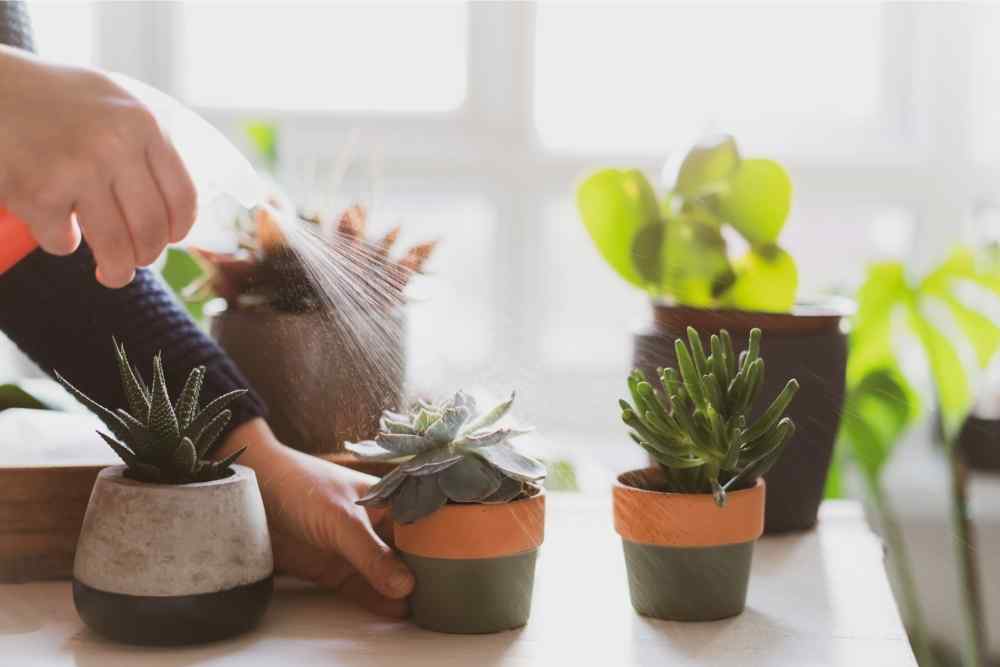
Can You Water Succulents with Ice Cubes?
No, succulents do not appreciate water that is too hot or too cold. Using melting ice cubes to water your succulent can cause root damage. Remember, succulents like warm, arid environments naturally.
Can You Overwater Succulents?
Yes, you can overwater! Overwatering is more of a danger to succulents than underwatering in most cases. Succulents that have been overwatered will have leaves that look as if they are about to burst. Sometimes they do! The succulent may have a translucent appearance, squishy leaves, or a deep brownish discoloration, much like a bruise.
This can be reversed by removing the plant from its container, drying out its roots for a few days, and repotting it with fresh soil.
Final Thoughts – How to Water Succulents
While succulents are one of the easier plants to manage, they still have environmental preferences. Succulents prefer arid, warm climates with relatively dry soil. Watering these plants once every few weeks may be all the water they need to thrive. Checking soil dryness can be done manually or with a moisture sensor device. If you notice overly dry soil or wrinkled leaves, these can signify that your plant is dehydrated.
Using properly aerated soil with a drainage system is the best way to care for your succulent plant. Monitoring exactly how much water you give your succulent can prevent them from being under or overwatered, which are both deadly for it. Succulent care can be fun and quite simple as long as you listen to its needs and give it what it asks for (in this case, the right amount of water!)



